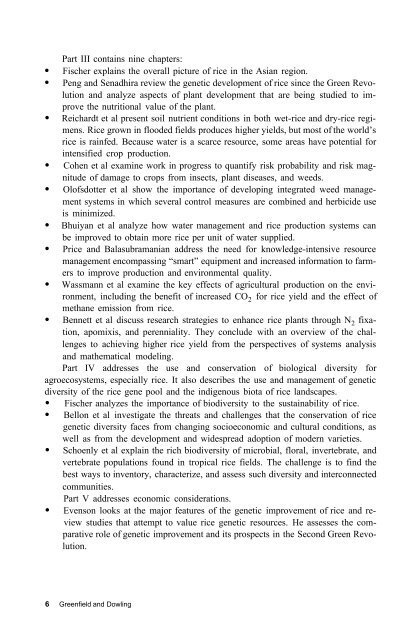Sustainability of rice in the global food system - IRRI books
Sustainability of rice in the global food system - IRRI books
Sustainability of rice in the global food system - IRRI books
You also want an ePaper? Increase the reach of your titles
YUMPU automatically turns print PDFs into web optimized ePapers that Google loves.
Part III conta<strong>in</strong>s n<strong>in</strong>e chapters:<br />
• Fischer expla<strong>in</strong>s <strong>the</strong> overall picture <strong>of</strong> <strong>rice</strong> <strong>in</strong> <strong>the</strong> Asian region.<br />
• Peng and Senadhira review <strong>the</strong> genetic development <strong>of</strong> <strong>rice</strong> s<strong>in</strong>ce <strong>the</strong> Green Revolution<br />
and analyze aspects <strong>of</strong> plant development that are be<strong>in</strong>g studied to improve<br />
<strong>the</strong> nutritional value <strong>of</strong> <strong>the</strong> plant.<br />
• Reichardt et al present soil nutrient conditions <strong>in</strong> both wet-<strong>rice</strong> and dry-<strong>rice</strong> regimens.<br />
Rice grown <strong>in</strong> flooded fields produces higher yields, but most <strong>of</strong> <strong>the</strong> world’s<br />
<strong>rice</strong> is ra<strong>in</strong>fed. Because water is a scarce resource, some areas have potential for<br />
<strong>in</strong>tensified crop production.<br />
• Cohen et al exam<strong>in</strong>e work <strong>in</strong> progress to quantify risk probability and risk magnitude<br />
<strong>of</strong> damage to crops from <strong>in</strong>sects, plant diseases, and weeds.<br />
• Ol<strong>of</strong>sdotter et al show <strong>the</strong> importance <strong>of</strong> develop<strong>in</strong>g <strong>in</strong>tegrated weed management<br />
<strong>system</strong>s <strong>in</strong> which several control measures are comb<strong>in</strong>ed and herbicide use<br />
is m<strong>in</strong>imized.<br />
• Bhuiyan et al analyze how water management and <strong>rice</strong> production <strong>system</strong>s can<br />
be improved to obta<strong>in</strong> more <strong>rice</strong> per unit <strong>of</strong> water supplied.<br />
• P<strong>rice</strong> and Balasubramanian address <strong>the</strong> need for knowledge-<strong>in</strong>tensive resource<br />
management encompass<strong>in</strong>g “smart” equipment and <strong>in</strong>creased <strong>in</strong>formation to farmers<br />
to improve production and environmental quality.<br />
• Wassmann et al exam<strong>in</strong>e <strong>the</strong> key effects <strong>of</strong> agricultural production on <strong>the</strong> environment,<br />
<strong>in</strong>clud<strong>in</strong>g <strong>the</strong> benefit <strong>of</strong> <strong>in</strong>creased CO 2 for <strong>rice</strong> yield and <strong>the</strong> effect <strong>of</strong><br />
methane emission from <strong>rice</strong>.<br />
• Bennett et al discuss research strategies to enhance <strong>rice</strong> plants through N 2 fixation,<br />
apomixis, and perenniality. They conclude with an overview <strong>of</strong> <strong>the</strong> challenges<br />
to achiev<strong>in</strong>g higher <strong>rice</strong> yield from <strong>the</strong> perspectives <strong>of</strong> <strong>system</strong>s analysis<br />
and ma<strong>the</strong>matical model<strong>in</strong>g.<br />
Part IV addresses <strong>the</strong> use and conservation <strong>of</strong> biological diversity for<br />
agroeco<strong>system</strong>s, especially <strong>rice</strong>. It also describes <strong>the</strong> use and management <strong>of</strong> genetic<br />
diversity <strong>of</strong> <strong>the</strong> <strong>rice</strong> gene pool and <strong>the</strong> <strong>in</strong>digenous biota <strong>of</strong> <strong>rice</strong> landscapes.<br />
• Fischer analyzes <strong>the</strong> importance <strong>of</strong> biodiversity to <strong>the</strong> susta<strong>in</strong>ability <strong>of</strong> <strong>rice</strong>.<br />
• Bellon et al <strong>in</strong>vestigate <strong>the</strong> threats and challenges that <strong>the</strong> conservation <strong>of</strong> <strong>rice</strong><br />
genetic diversity faces from chang<strong>in</strong>g socioeconomic and cultural conditions, as<br />
well as from <strong>the</strong> development and widespread adoption <strong>of</strong> modern varieties.<br />
• Schoenly et al expla<strong>in</strong> <strong>the</strong> rich biodiversity <strong>of</strong> microbial, floral, <strong>in</strong>vertebrate, and<br />
vertebrate populations found <strong>in</strong> tropical <strong>rice</strong> fields. The challenge is to f<strong>in</strong>d <strong>the</strong><br />
best ways to <strong>in</strong>ventory, characterize, and assess such diversity and <strong>in</strong>terconnected<br />
communities.<br />
Part V addresses economic considerations.<br />
• Evenson looks at <strong>the</strong> major features <strong>of</strong> <strong>the</strong> genetic improvement <strong>of</strong> <strong>rice</strong> and review<br />
studies that attempt to value <strong>rice</strong> genetic resources. He assesses <strong>the</strong> comparative<br />
role <strong>of</strong> genetic improvement and its prospects <strong>in</strong> <strong>the</strong> Second Green Revolution.<br />
6 Greenfield and Dowl<strong>in</strong>g

















